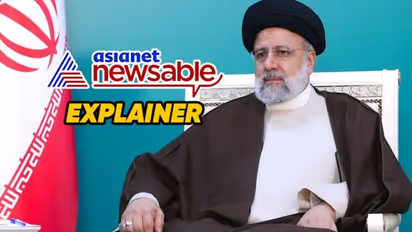Iran President Raisi dies in chopper crash: Legacy of 'The Butcher of Tehran' & succession protocol explained

Synopsis
Iranian President Ebrahim Raisi, alongside his foreign minister Hossein Amir Abdollahian, were on Monday confirmed dead in a helicopter crash near Jolfa, a city bordering Azerbaijan.
Iranian President Ebrahim Raisi, alongside his foreign minister Hossein Amir Abdollahian, were on Monday confirmed dead in a helicopter crash near Jolfa, a city bordering Azerbaijan. "President Raisi, the foreign minister and all the passengers in the helicopter were killed in the crash," a senior Iranian official was quoted as saying in a Reuters report.
The loss of Raisi, a controversial figure whose tenure was marked by hardline policies and domestic repression, raises questions about Iran's future leadership and the ramifications of his departure.
Raisi was personally involved in two of the darkest periods of Iranian repression.
A year after his election, the mid-ranking cleric ordered that authorities tighten the enforcement of Iran's "hijab and chastity law" restricting women's attire and behaviour.
Iran saw a wave of protests triggered by the death in custody of Iranian-Kurdish woman Mahsa Amini in September 2022 after her arrest for allegedly flouting dress rules for women.
The nationwide protests presented one of the gravest challenges to Iran's clerical rulers since the 1979 Islamic Revolution.
Hundreds were killed, according to rights groups, including dozens of security personnel who were part of a fierce crackdown on the demonstrators as the president insisted "acts of chaos are unacceptable."
Why Raisi was labelled 'The Butcher of Tehran'
For Iran's exiled opposition and human rights organizations, the name Raisi brings to mind the mass executions of Marxists and other leftists in 1988, during his tenure as deputy prosecutor of the Revolutionary Court in Tehran.
Inquisitions, known as "death committees," were established throughout Iran, comprised of religious judges, prosecutors, and intelligence ministry officials. These committees swiftly determined the fate of thousands of detainees in brief and arbitrary trials, as detailed in a report by Amnesty International.
While the precise number of casualties across Iran remains unconfirmed, Amnesty International reported a minimum estimate of 5,000 individuals killed.
The 1988 mass executions earned Raisi the infamous moniker of 'The Butcher of Tehran'.
Raisi - A conservative hardliner
Ebrahim Raisi, aged 63, ascended within Iran's theocratic system from a hardline prosecutor to an uncompromising president, overseeing a crackdown on domestic protests and taking a firm stance in nuclear negotiations with global powers.
Raisi's career trajectory began in the aftermath of the 1979 Islamic revolution, during which he developed a close relationship with supreme leader Ayatollah Ali Khamenei.
In line with Khamenei's stance, Raisi frequently voiced defiance as Iran, the largest Shiite Muslim nation, grappled with a tense standoff against its declared adversaries, the United States and Israel. Raisi's inclusion on Washington's sanctions list stems from allegations of complicity in "serious human rights violations."
During the nuclear negotiations, Raisi adopted a tough stance, viewing an opportunity to secure extensive relief from US sanctions in exchange for only modest constraints on Iran's increasingly advanced nuclear capabilities.
Following then-US President Donald Trump's withdrawal from the 2015 nuclear agreement between Iran and six world powers, which led to the reimposition of severe US sanctions on Iran, Tehran gradually began breaching the accord's nuclear restrictions.
Efforts to revive the nuclear deal through indirect talks between Tehran and the administration of US President Joe Biden have hit a deadlock.
Iran-Israel tensions
Raisi's tenure also witnessed escalating tensions with Israel, culminating in a series of tit-for-tat escalations and direct missile strikes targeting Israeli territory. His unwavering support for Palestine and defiance against Israel underscored his commitment to Iran's foreign policy objectives, even in the face of international condemnation.
"We believe that Palestine is the first issue of the Muslim world, and we are convinced that the people of Iran and Azerbaijan always support the people of Palestine and Gaza and hate the Zionist regime," Raisi had said.
What happens if an Iranian president dies in office?
With Raisi's sudden demise, Iran now faces the challenge of succession in accordance with its constitutional provisions.
As per Article 131 of the Islamic Republic's constitution, in the event of the death of a president while in office, the first vice president assumes the presidency, subject to confirmation by the Supreme Leader, who holds the ultimate authority in all state matters.
A council comprising the first vice president, the speaker of parliament, and the head of the judiciary is mandated to organize a presidential election within a maximum period of 50 days following the death of the president.
The passing of Raisi not only leaves a void in Iran's political landscape but also raises questions about the trajectory of the country's domestic and foreign policies. As a staunch conservative and close ally of Supreme Leader Ayatollah Ali Khamenei, Raisi wielded significant influence over Iran's direction, particularly in sensitive areas such as nuclear negotiations and regional conflicts.
In the aftermath of Raisi's demise, Iran finds itself at a crossroads, grappling with the legacy of a divisive leader while navigating the complexities of leadership succession. The events following his death will shape the future trajectory of Iranian politics and have far-reaching implications for the country's relations with the international community.
Check the Breaking News Today and Latest News from across India and around the world. Stay updated with the latest World News and global developments from politics to economy and current affairs. Get in-depth coverage of China News, Europe News, Pakistan News, and South Asia News, along with top headlines from the UK and US. Follow expert analysis, international trends, and breaking updates from around the globe. Download the Asianet News Official App from the Android Play Store and iPhone App Store for accurate and timely news updates anytime, anywhere.